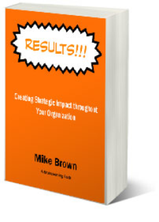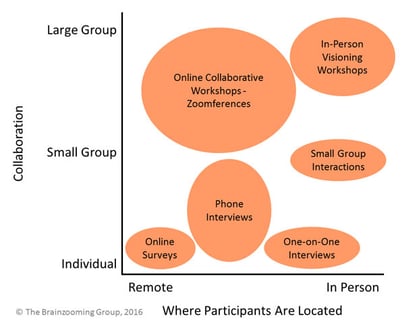During in-person and online strategic planning workshops, we regularly use a strategic thinking exercise that helps leadership groups quickly identify a shared future vision statement. Participants assess where they think the organization currently is and where they want it to be in the future on multiple "strategic dimensions." The strategic dimensions relate to significant aspirations, big goals, major strategic decisions, and other factors defining the organization.
We place each strategic dimension on a scale having multiple written descriptions of ways to approach it. The descriptions are purposely neither good nor bad; they simply represent ways an organization could pursue the strategy. This strategic thinking exercise allows a large group (perhaps hundreds of online participants) to provide targeted input on an organization's future direction. We turn that input into a collaborative vision statement.
Pushing Back on a Strategic Thinking Exercise
Adapting this strategic thinking exercise for a client, however, we experienced MAJOR push back. They saw it as too prescriptive, i.e., limiting participants to four strategic dimensions the CEO articulated based on meeting hundreds of employees across the organization. They suggested letting the nearly fifty participants work together to generate the strategic dimensions they could use to describe a future vision. The hope was they will come up with something similar to the original four focus areas.
So we pushed back.
The idea of a leader collaboratively determining the direction an organization should go is rare. But making fifty top executives "guess" and articulate what the CEO already thinks (which is very common) is a recipe for wasted time and a frustrating strategy meeting. As regular Brainzooming readers understand, we're proponents for using structure (instead of blank pieces of paper) to make it easy for any employee to successfully contribute to developing strategy.
An Alternative Strategic Thinking Exercise to Develop a Vision Statement
This situation got me thinking, though: If I can't persuade them to use a strategic thinking exercise we KNOW works to create a future vision statement, what could we do differently, in nearly the same amount of meeting time (thirty to forty-five minutes) to deliver comparable results?
Here’s our alternative approach for a strategic thinking exercise that could address the client's concerns:
Split the large group into smaller ones, sending them to big easel pad sheets around the room. Posters would contain strategic thinking questions, such as:
- In what areas can we set ourselves apart from competitors most dramatically?
- Where do we have opportunities to create the greatest impact for our clients?
- What will be the biggest factors determining whether we flourish or not as an organization?
- How could we diversify what we do as an organization?
The small groups would rotate through two posters each, spending five minutes generating ideas for the strategic thinking questions. That's ten minutes down.
On the third round, the group arriving at a poster would multi-vote on the most important idea on the poster and re-describe it (if necessary) in a few words. There's another eight minutes or so; we're a third of the way done, timewise.
The fourth group at a poster would shift to a separate easel sheet featuring a line with an odd number of points on it. In the middle, they would describe (in a few words), the organization’s current position on that dimension. To the far left, they would describe an attractive, market-viable position, albeit one simpler, more direct, more streamlined, or one easier for the organization to target.
On the far right, they would describe a dramatically bigger, more aspirational, grander, or more sweeping position the organization could target. Again, the position has to be possible and viable for the organization, although it might take years to reach. In between, they would describe where one or two other competitors or industry players are, ideally one on each side of where the organization is right now. Since I'm GENEROUS about time, they would have fifteen minutes to create these few descriptions.
At this point, we’ve already used nearly all the original time. Taking advantage of the multi-day session and using our online collaboration platform, however, they would return the next morning to complete the work. They'd have a sheet with each of the scales and the various positions. The strategic dimensions and scales would be ready in our online collaboration platform. Participants can then provide input online regarding where the organization is now and where it should be in a few years.
What are the downsides?
The total time on the strategic thinking exercise would likely be 1.5 to 2 times longer. It will be spaced over multiple days. The options they consider aren't likely to be as strategically neutral as in the original approach. We also risk getting into the weeds and spending time on areas where the CEO doesn't want to focus.
In answer to the concerns, however, this particular group will gain a stronger sense of starting from scratch than they might have using our tested approach.
Thanks for tolerating a Brainzooming longer article today. In case you hadn't guessed, this is written for my client as a potential alternative to consider. We’ll know tomorrow which way they decided to go! - Mike Brown
10 Keys to Engaging Stakeholders to Improve Strategic Results
FREE Download: "Results!!! Creating Strategic Impact"
Leaders need high-impact ways to develop employees that can provide input into strategy and then turn it into results. This Brainzooming mini-book, "Results - Creating Strategic Impact" unveils ten proven lessons leaders can use to boost collaboration, meaningful strategic conversations, and results.
Download this free, action-focused mini-book to:
- Learn smart ways to separate strategic opportunities from the daily noise of business
- Increase focus for your team with productive strategy questions everyone can use
- Actively engage stakeholders in strategy AND implementation success







